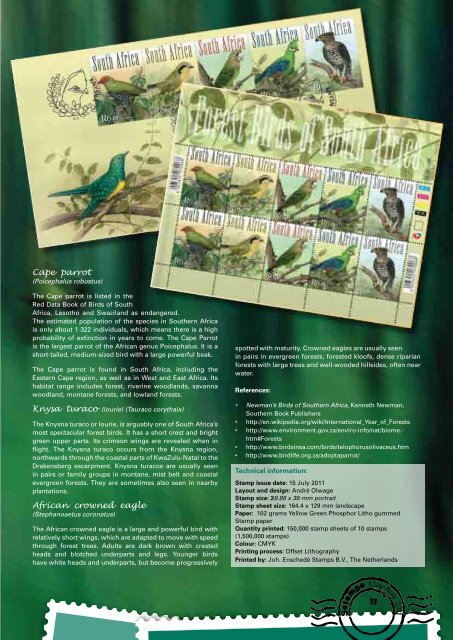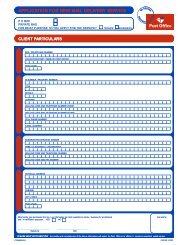new issues... - Virtual Post Office
new issues... - Virtual Post Office
new issues... - Virtual Post Office
Create successful ePaper yourself
Turn your PDF publications into a flip-book with our unique Google optimized e-Paper software.
Cape parrot<br />
(Poicephalus robustus)<br />
The Cape parrot is listed in the<br />
Red Data Book of Birds of South<br />
Africa, Lesotho and Swaziland as endangered.<br />
The estimated population of the species in Southern Africa<br />
is only about 1 322 individuals, which means there is a high<br />
probability of extinction in years to come. The Cape Parrot<br />
is the largest parrot of the African genus Poicephalus. It is a<br />
short-tailed, medium-sized bird with a large powerful beak.<br />
The Cape parrot is found in South Africa, including the<br />
Eastern Cape region, as well as in West and East Africa. Its<br />
habitat range includes forest, riverine woodlands, savanna<br />
woodland, montane forests, and lowland forests.<br />
Knysa turaco (lourie) (Tauraco corythaix)<br />
The Knysna turaco or lourie, is arguably one of South Africa’s<br />
most spectacular forest birds. It has a short crest and bright<br />
green upper parts. Its crimson wings are revealed when in<br />
fl ight. The Knysna turaco occurs from the Knysna region,<br />
northwards through the coastal parts of KwaZulu-Natal to the<br />
Drakensberg escarpment. Knysna turacos are usually seen<br />
in pairs or family groups in montane, mist belt and coastal<br />
evergreen forests. They are sometimes also seen in nearby<br />
plantations.<br />
African crowned eagle<br />
(Stephanoaetus coronatus)<br />
The African crowned eagle is a large and powerful bird with<br />
relatively short wings, which are adapted to move with speed<br />
through forest trees. Adults are dark brown with crested<br />
heads and blotched underparts and legs. Younger birds<br />
have white heads and underparts, but become progressively<br />
spotted with maturity. Crowned eagles are usually seen<br />
in pairs in evergreen forests, forested kloofs, dense riparian<br />
forests with large trees and well-wooded hillsides, often near<br />
water.<br />
References:<br />
• Newman’s Birds of Southern Africa, Kenneth Newman,<br />
Southern Book Publishers<br />
• http://en.wikipedia.org/wiki/International_Year_of_Forests<br />
• http://www.environment.gov.za/enviro-info/nat/biome.-<br />
htm#Forests<br />
• http://www.birdsinsa.com/birds/telophorusolivaceus.htm<br />
• http://www.birdlife.org.za/adoptaparrot/<br />
Technical information:<br />
Stamp issue date: 15 July 2011<br />
Layout and design: André Olwage<br />
Stamp size: 28.88 x 38 mm portrait<br />
Stamp sheet size: 164.4 x 129 mm landscape<br />
Paper: 102 grams Yellow Green Phosphor Litho gummed<br />
Stamp paper<br />
Quantity printed: 150,000 stamp sheets of 10 stamps<br />
(1,500,000 stamps)<br />
Colour: CMYK<br />
Printing process: Offset Lithography<br />
Printed by: Joh. Enschedé Stamps B.V., The Netherlands<br />
11<br />
Setempe May-Aug 2011





